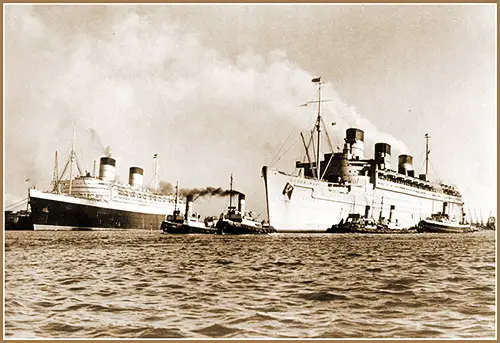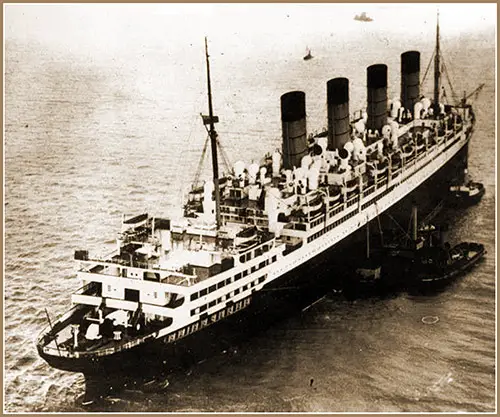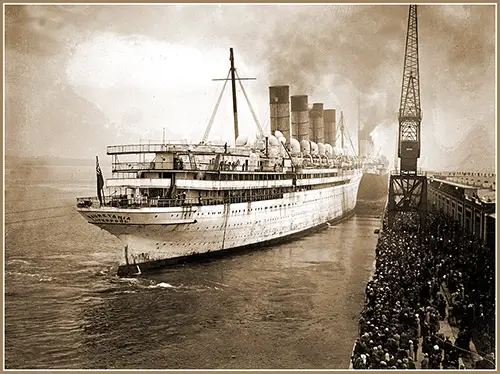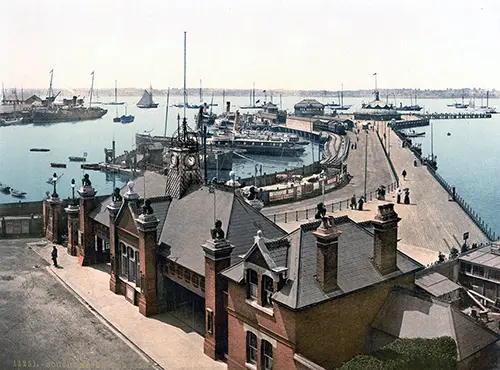Southampton Passenger Lists 1930-1964

View of the RMS Queen Elizabeth on the left and the RMS Queen Mary on the right at Southampton on September 27, 1946. The photo was taken just before the RMS Queen Elizabeth's sea trials, having been completed and fully repainted in Cunard livery. RMS Queen Mary is still in her war colors as she was concluding her war duties on this day. | GGA Image ID # 1d43f54063
Note: Typically, only the origination and final destination ports are listed in each link. Other intermediary ports of call are not listed.
======== 1930s ========
Baltimore Mail Line 1930s
Canadian Pacific Line 1930s
Compagnie Générale Transatlantique / CGT - French Line 1930s
- 1935-07-24 SS Normandie - Le Havre to New York
- 1936-06-17 SS Lafayette - Le Havre to New York
- 1936-07-29 SS Normandie - Le Havre To New York
- 1937-04-15 SS Ile De France - Le Havre to New York
- 1937-07-21 SS Ile de France - Le Havre to New York
- 1937-09-25 SS Normandie - Le Havre To New York
- 1937-11-03 SS Normandie - Le Havre to New York
- 1938-08-10 SS Normandie - Le Havre to New York
- 1938-08-24 SS Normandie - Le Havre to New York
- 1938-09-17 SS Champlain - Le Havre to New York
- 1938-10-05 SS Normandie - Le Havre to New York
- 1939-07-15 SS Ile De France - Le Havre to New York
- 1939-07-19 SS Champlain - Le Havre to New York
Cunard Line 1930s
- 1930-01-29 RMS Aquitania - Southampton to New York
- 1930-04-05 RMS Aquitania - Southampton to New York
- 1930-07-12 RMS Ascania - Southampton to Québec and Montréal
- 1930-07-26 RMS Berengaria - Southampton to New York
- 1930-07-26 RMS Tuscania - Southampton to New York
- 1930-08-02 RMS Mauretania - Southampton to New York
- 1930-08-16 RMS Berengaria - Southampton to New York
- 1930-08-30 RMS Carmania - Southampton to New York
- 1930-09-06 RMS Lancastria - Southampton to New York
- 1930-09-20 RMS Ausonia - Southampton to Québec and Montréal
- 1930-10-25 RMS Carmania - Southampton to New York
- 1931-05-02 RMS Berengaria - Southampton to New York
- 1931-07-18 RMS Aquitania - Southampton to New York
- 1931-08-01 RMS Mauretania - Southampton to New York
- 1931-08-22 RMS Mauretania - Southampton to New York
- 1931-08-29 RMS Samaria - Southampton to New York
- 1931-09-12 RMS Caronia - Southampton to New York
- 1932-04-06 RMS Mauretania - Southampton to New York
- 1932-06-04 RMS Ausonia - Southampton to Québec and Montréal
- 1932-09-10 RMS Aurania - Southampton to Québec and Montréal
- 1932-09-17 RMS Berengaria - Southampton to New York
- 1932-10-01 RMS Aquitania - Southampton to New York
- 1933-07-29 RMS Berengaria - Southampton to New York
- 1933-09-02 RMS Berengaria - Southampton to New York
- 1934-05-05 RMS Berengaria - Southampton to New York
- 1935-06-26 RMS Berengaria - Southampton to New York
- 1935-09-11 RMS Berengaria - Southampton to New York
- 1935-09-18 RMS Aquitania - Southampton to New York
- 1936-08-05 RMS Queen Mary - Southampton to New York
- 1936-08-26 RMS Aquitania - Southampton to New York
- 1936-09-02 RMS Queen Mary - Southampton to New York
- 1937-06-09 RMS Queen Mary - New York to Southampton
- 1937-07-28 RMS Aquitania - Southampton to New York
- 1937-08-07 RMS Ausonia - Southampton to Montréal and Québec
- 1938-06-01 RMS Aquitania - New York to Cherbourg
- 1938-08-10 RMS Aquitania - Southampton to New York
- 1938-08-24 RMS Aquitania - Southampton to New York
- 1938-08-27 RMS Alaunia - Southampton to Québec and Montréal
- 1938-09-07 RMS Aquitania - Southampton to New York
- 1938-10-15 RMS Ausonia - Southampton to Montréal and Québec
- 1938-10-29 RMS Queen Mary - Southampton to New York
- 1938-11-12 RMS Queen Mary - Southampton to New York
- 1939-04-22 RMS Aquitania - Southampton to New York
- 1939-05-17 RMS Aquitania - New York to Southampton
- 1939-06-07 RMS Aquitania - Southampton to New York
- 1939-07-12 RMS Queen Mary - Southampton to New York
- 1939-09-09 RMS Aquitania - Southampton to New York
Hamburg-American Line / Hamburg-Amerika Linie (HAPAG) 1930s
- 1930-08-22 SS Deutschland - Hamburg to New York
- 1930-08-29 SS Hamburg - Hamburg to New York
- 1931-05-21 SS New York - Hamburg to New York
- 1931-10-08 SS New York - Hamburg to New York
- 1932-09-18 SS Milwaukee - Hamburg to New York
- 1933-07-27 SS New York - Hamburg to New York
- 1933-08-24 SS New York - Hamburg to New York
- 1933-12-20 SS Albert Ballin - Hamburg to New York
- 1934-08-02 SS Hamburg - Hamburg to New York
- 1934-08-09 SS New York - Hamburg to New York
- 1934-08-30 SS Hamburg - Hamburg to New York
- 1934-09-06 SS New York - Hamburg to New York
- 1935-07-11 SS Hamburg - New York to Hamburg
- 1935-08-15 SS Deutschland - Hamburg to New York
- 1935-08-21 SS Hamburg - Hamburg to New York
- 1936-05-28 SS New York - New York to Hamburg
- 1936-06-04 SS Hamburg - New York to Hamburg
- 1936-07-02 SS Hamburg - New York to Hamburg
- 1936-08-27 SS Deutschland - Hamburg to New York
- 1937-09-02 SS Hamburg - Hamburg to New York
- 1937-09-14 SS Stuttgart - Hamburg to New York
- 1937-09-25 SS Normandie Le Havre To New York
- 1938-08-04 SS Hamburg - Hamburg to New York
- 1938-11-03 SS New York - Hamburg to New York
- 1939-04-20 SS Hamburg - Hamburg to New York
- 1939-05-11 SS New York - New York to Hamburg
- 1939-06-08 SS New York - New York to Hamburg
Holland-America Line 1930s
- 1930-07-26 TSS Nieuw Amsterdam - Rotterdam to New York
- 1930-07-04 SS Statendam - Rotterdam to New York
- 1930-08-09 TSS Rotterdam - Rotterdam to New York
- 1930-09-27 TSS Statendam - Rotterdam to New York
- 1931-10-09 TSS Rotterdam - Rotterdam to New York
- 1932-08-26 TSS Statendam - Rotterdam to New York
- 1933-09-02 TSS Rotterdam - Rotterdam to New York
- 1934-05-26 TSS Rotterdam - Rotterdam to New York
- 1934-08-25 TSS Statendam - Rotterdam to New York
- 1934-10-06 TSS Statendam - Rotterdam to New York
- 1936-08-06 TSS Statendam - Rotterdam to New York
- 1937-07-10 TSS Statendam - Rotterdam to New York
- 1937-07-24 TSS Veendam - Rotterdam to New York
- 1937-08-06 TSS Statendam - Rotterdam to New York
- 1937-08-11 TSS Rotterdam - Rotterdam to New York
- 1937-09-04 TSS Veendam - Rotterdam to New York
- 1938-08-20 TSS Statendam - Rotterdam to New York
- 1938-08-27 TSS Nieuw Amsterdam - Rotterdam to New York
- 1938-10-01 TSS Statendam - Rotterdam to New York
- 1939-09-09 SS Volendam - Antwerp to New York
North German Lloyd / Norddeutscher Lloyd - 1930s
- 1930-07-05 SS Europa - New York to Bremen
- 1930-08-13 SS Bremen - Bremen to New York
- 1930-09-29 SS Columbus - Bremen to New York
- 1930-10-03 SS Bremen - Bremen to New York
- 1931-08-27 SS Bremen - Bremen to New York
- 1931-09-15 SS Bremen - Bremen to New York
- 1932-07-01 SS Bremen - Bremen to New York
- 1932-08-21 SS Bremen - Bremen to New York
- 1932-09-01 SS Europa - Bremen to New York
- 1932-09-17 SS Europa - Bremen to New York
- 1933-03-23 SS Bremen - Bremen to New York
- 1933-09-28 SS Stuttgart - Bremen to Halifax and New York
- 1934-07-25 SS Europa - New York to Bremen
- 1934-07-27 SS Bremen - Bremen to New York
- 1934-08-17 SS Bremen - Bremen to New York
- 1934-08-24 SS Europa - Bremen to New York
- 1935-04-12 SS Bremen - Bremen to New York
- 1935-07-17 SS Europa - New York to Bremen
- 1935-07-26 SS Europa - Bremen to New York
- 1935-09-03 SS Europa - Bremen to New York
- 1935-10-18 SS Bremen - Bremen to New York
- 1936-01-24 SS Europa - Bremen to New York
- 1936-05-20 SS Europa - New York to Bremen
- 1936-06-13 SS Europa - Bremen to New York
- 1936-06-14 SS Bremen - New York to Bremen
- 1936-06-23 SS Bremen - Bremen to New York
- 1936-07-09 SS Bremen - Bremen to New York
- 1936-08-14 SS Bremen - Bremen to New York
- 1936-08-21 SS Europa - Bremen to New York
- 1936-08-29 SS Bremen - Bremen to New York
- 1936-09-12 SS Columbus - Bremen to New York
- 1936-10-17 SS Bremen - Bremen to New York
- 1937-06-02 SS Bremen - Bremen to New York
- 1937-06-19 SS Europa - New York to Bremen
- 1937-07-07 SS Europa - New York to Bremen
- 1937-07-16 SS Europa - Bremen to New York
- 1937-07-27 SS Bremen - Bremen to New York
- 1937-08-19 SS Europa - Bremen to New York
- 1937-08-31 SS Berlin - Bremen to New York
- 1937-10-08 SS Europa - Bremen to New York
- 1937-10-19 SS Bremen - Bremen to New York
- 1938-05-03 SS Bremen - Bremen to New York
- 1938-06-24 SS Bremen - Bremen to New York
- 1938-07-19 SS Europa - Bremen to New York
- 1938-08-16 SS Bremen - Bremen to New York
- 1938-10-22 SS Bremen - Bremen to New York
Red Star Line 1930s
Royal Mail Lines 1930s
Union-Castle Line
United States Lines 1930s
- 1930-08-05 SS George Washington - Hamburg to New York
- 1930-09-08 SS America - Hamburg to New York
- 1930-09-17 SS President Harding - Hamburg to New York
- 1930-09-25 SS George Washington - Hamburg to New York
- 1931-07-28 SS America - Hamburg to New York
- 1931-09-08 SS George Washington - Hamburg to New York
- 1932-08-24 SS Manhattan - Hamburg to New York
- 1932-09-09 SS Leviathan - Bremen to New York
- 1932-10-19 SS Manhattan - Hamburg to New York
- 1932-11-25 SS Leviathan - Bremen to New York
- 1933-05-24 SS Washington - Hamburg to New York
- 1933-12-29 SS Washington - Hamburg to New York
- 1934-05-23 SS Washington - Hamburg to New York
- 1934-08-01 SS Manhattan - Hamburg to New York
- 1934-08-15 SS Washington - Hamburg to New York
- 1934-10-24 SS Manhattan - Hamburg to New York
- 1934-11-07 SS Washington - Hamburg to New York
- 1935-04-10 SS Manhattan - Hamburg to New York
- 1935-05-28 SS President Roosevelt - Hamburg to New York
- 1935-07-31 SS Manhattan - Hamburg to New York
- 1936-03-11 SS Manhattan - Hamburg to New York
- 1936-07-29 SS Manhattan - Hamburg to New York
- 1936-09-09 SS Washington - Hamburg to New York
- 1936-10-21 SS Manhattan - Hamburg to New York
- 1937-09-01 SS President Harding - Hamburg to New York
- 1938-04-20 SS Washington - Hamburg to New York
- 1938-06-29 SS Manhattan - Hamburg to New York
- 1938-08-31 SS President Roosevelt - Hamburg to New York
- 1938-09-30 SS Washington - Le Havre to New York
- 1938-09-14 SS President Harding - Hamburg to New York
- 1939-08-22 SS Washington - Hamburg to New York
White Star Line 1930s
- 1930-02-27 SS Laurentic - Mediterranean Cruise from New York to Southampton
- 1930-08-06 RMS Homeric - Southampton to New York
- 1930-08-22 SS Megantic - Southampton to Québec and Montréal
- 1930-10-01 RMS Majestic - Southampton to New York
- 1931-06-24 RMS Homeric - Southampton to New York
- 1932-08-10 RMS Majestic - Southampton to New York
- 1933-08-23 RMS Majestic - Southampton to New York
- 1934-08-08 RMS Majestic - Southampton to New York
- 1935-09-04 RMS Majestic - Southampton to New York
- 1935-10-04 RMS Britannic - Le Havre to New York
- 1936-08-08 RMS Britannic -Southampton to New York
- 1936-10-17 RMS Georgic - Southampton to New York
- 1937-07-24 RMS Georgic - Southampton to New York
- 1937-08-07 RMS Britannic - Southampton to New York
- 1937-09-17 RMS Georgic - Le Havre to New York
- 1937-10-16 RMS Georgic - Southampton to New York
- 1938-10-15 RMS Britannic - Southampton and Le Havre
- 1939-07-08 SS Georgic - New York to London

The RMS Aquitania of the Cunard Line is Grounded on Thorne Knoll Near Southampton, 1935. | GGA Image ID # 1d4423282a
======== 1940s ========
Cunard Line 1940s
- 1947-02-13 RMS Queen Elizabeth - Southampton to New York
- 1947-05-24 RMS Queen Elizabeth - New York to Southampton
- 1947-09-11 RMS Queen Elizabeth - Southampton to New York
- 1947-09-19 RMS Queen Mary - Southampton to New York
- 1947-10-14 RMS Mauretania - Southampton to New York
- 1948-05-14 RMS Queen Elizabeth - New York to Southampton
- 1948-05-22 RMS Queen Mary - New York to Southampton
- 1948-06-24 RMS Queen Elizabeth - Southampton to New York
- 1948-07-02 RMS Queen Mary - Southampton to New York
- 1948-08-07 RMS Queen Mary - Southampton to New York
- 1948-09-07 RMS Mauretania - Southampton to New York
- 1948-09-28 RMS Mauretania - Southampton to New York
- 1948-10-31 RMS Queen Elizabeth - Southampton to New York
- 1949-04-26 RMS Mauretania - Southampton to New York
- 1949-05-04 RMS Mauretania - New York to Southampton
- 1949-05-06 RMS Queen Elizabeth - Southampton to New York
- 1949-06-23 RMS Queen Elizabeth - Southampton to New York
- 1949-08-27 RMS Queen Elizabeth - Southampton to New York
- 1949-10-14 RMS Queen Elizabeth - Southampton to New York
- 1949-10-22 RMS Queen Mary - Southampton to New York
Holland-America Line 1940s
Orient Line 1940s
Union-Castle Line 1940s
United States Lines 1940s
======== 1950s ========
Canadian Pacific Line 1950s
Compagnie Générale Transatlantique / CGT - French Line 1950s
Cunard Line 1950s
- 1950-01-28 RMS Queen Mary - New York to Southampton
- 1950-02-08 RMS Queen Mary - Southampton to New York
- 1950-05-24 RMS Queen Mary - New York to Southampton
- 1950-10-07 RMS Queen Mary - Southampton to New York
- 1950-10-14 RMS Queen Mary - New York to Southampton
- 1950-11-16 RMS Queen Elizabeth - Southampton to New York
- 1951-04-07 RMS Queen Mary - Southampton to New York
- 1951-08-15 RMS Queen Mary - Southampton to New York
- 1951-11-13 RMS Mauretania - Southampton to New York
- 1952-05-07 RMS Queen Elizabeth - New York to Southampton
- 1952-06-05 RMS Queen Mary - Southampton to New York
- 1952-06-18 RMS Queen Elizabeth - New York to Southampton
- 1952-08-07 RMS Queen Mary - Southampton to New York
- 1953-03-20 RMS Scythia - Southampton to Halifax
- 1953-03-28 RMS Queen Mary - New York to Southampton
- 1953-06-11 RMS Queen Elizabeth - Southampton to New York
- 1953-07-01 RMS Queen Mary - Southampton to New York
- 1953-08-04 RMS Mauretania - Southampton to New York
- 1953-08-12 RMS Queen Mary - New York to Southampton
- 1953-09-16 RMS Queen Mary - Southampton to New York
- 1954-05-27 RMS Mauretania - New York to Southampton
- 1954-07-01 RMS Queen Mary - Southampton to New York
- 1954-07-07 RMS Queen Mary - New York to Southampton
- 1954-07-15 RMS Mauretania - Southampton to New York
- 1954-07-28 RMS Queen Mary - New York to Southampton
- 1954-08-26 RMS Queen Elizabeth - Southampton to New York
- 1954-12-23 RMS Queen Elizabeth - Southampton to New York
- 1955-02-19 RMS Queen Mary - Southampton to New York
- 1955-08-17 RMS Queen Elizabeth - New York to Southampton
- 1955-09-22 RMS Queen Elizabeth - Southampton to New York
- 1956-09-18 RMS Mauretania - Southampton to New York
- 1957-08-08 RMS Queen Elizabeth - Southampton to New York
Holland-America Line 1950s
Home Lines 1950s
Union-Castle Line 1950s
United States Lines 1950s
======== 1960s ========
Cunard Line 1960s
Holland-America Line 1960s
Note: Typically, only the origination and final destination ports are listed in each link. Other intermediary ports of call are not listed.
More Information About the Port of Southampton

The Image Shows the RMS Mauretania Departing Southampton on 2 July 1935. She Was One of the Three Express Liners of the Cunard Line - The Lusitania, Aquitania, and Mauretania. She Had Been Sold to Metal Industries, Who Would Soon Break up This Fine Liner. The RMS Olympic Is Visible in the Background. GGA Image ID # 1d44393290
From several points of view, Southampton is one of the most exciting ports in the British Isles. It is, for instance, an outstanding example of a port developed by a railroad company for the sake of the passenger traffic commanded by a favorable location.
Then it possesses the extraordinary phenomenon of four tides a day. A glance at the map will understand the explanation of this natural endowment. One will see that Southampton lies some six miles up Southampton Water and that opposite the end of this deep inlet stands the Isle of Wight.

The Piers at Southampton, 1905. The Detroit Publishing Company Print # 11251. | GGA Image ID # 1d44abb6dc
When a tide sweeps up the English Channel, it sweeps up Southampton Water. Still, when the ebb tide begins through the Channel and sweeps again past the Isle of Wight, the flood is held in Southampton Water and cannot get out.
The result is that two hours after every high tide in the English Channel, it is high tide for a second time at Southampton. Thus Southampton has practically four hours of the high tide every twenty-four hours.
When released from their wartime service, the Aquitania and the Olympic, the two largest British-built ships, were placed on this express terry between Southampton and New York.
The Mauretania and the ex-German Berengaria have all been in the big dock at Southampton simultaneously, forming a unique spectacle.
By the way, this dock is, from prolonged usage by the White Star Line, called the "White Star Dock." The name, of course, is not precisely relished by the Cunard Company, whose big liners are also obliged to use it.
Particulars of the White Star Dock, the largest and deepest at Southampton, are as follows:
- Water area, 16 acres
- Length of quayage, 3,800 feet
- Length of the dock, 1,600 feet
- Width of the entrance 400 feet
- Depth of high water, ordinary spring tides, 53 feet
- Depth at low water, ordinary spring tides, 40 feet
Related Categories
Steamship & Ocean Liners
- Alaunia
- Albert Ballin
- America
- Aquitania
- Ascania
- Asturias
- Atlantic
- Aurania
- Ausonia
- Belgenland
- Berengaria
- Bremen
- Britannic
- Capetown Castle
- Carmania
- Caronia
- Champlain
- City Of Baltimore
- City of Newport News
- City of Norfolk
- Columbus
- Deutschland
- Duchess of Richmond
- Edinburgh Castle
- Empress of Australia
- Empress of Scotland
- Europa
- George Washington
- Georgic
- Hamburg
- Homeric
- Ile De France
- Lafayette
- Lancastria
- Lapland
- Laurentic
- Leviathan
- Liberté
- Maasdam
- Majestic
- Manhattan
- Mauretania
- Mauretania 2
- Megantic
- Milwaukee
- Montrose
- New York
- Nieuw Amsterdam
- Normandie
- Orion
- Pennland
- President Harding
- President Roosevelt
- Queen Elizabeth
- Queen Mary
- Rotterdam
- Samaria
- Scythia
- Statendam
- Stirling Castle
- Stuttgart
- Tuscania
- Veendam
- Volendam
- Warwick Castle
- Washington
- Winchester Castle
Ephemera & History
- Baltimore Mail Line
- Canadian Pacific Line
- CGT - French Line
- Cunard Line
- Hamburg-American Line
- Holland-America Line
- Home Lines
- North German Lloyd
- Orient Line
- Red Star Line
- Royal Mail Lines
- Union-Castle Line
- United States Lines
- White Star Line
By Year of Voyage
By Port of Call
- Antwerp
- Baltimore
- Bremen
- Buenos Aires
- Capetown
- Durban
- Halifax
- Hamburg
- Le Havre
- London
- Montréal
- New York
- Norfolk
- Québec
- Rotterdam
- Southampton
- Sydney
Ports of Call Information
- Antwerp
- Bremen/Bremerhaven
- Hamburg
- London
- New York - Pre-WW2
- New York - Post-WW2
- Norfolk
- Rotterdam
- Southampton
SS RMS MV - Defined
A. Vernon Thomas, "Southampton's Present Prosperity Duet to Railway Company's Improvements," in The Nautical Gazette, New York: The Nautical Gazette, Inc., Vol. 101, No. 13, Whole No. 2614, 24 September 1921, pp. 394-395.
⚠️ About Accuracy in Historical Records Research Tip
Context. The GG Archives presents passenger lists as faithfully as possible to the original documents. While OCR is generally accurate, portions of these collections—especially image captions and some transcriptions—are typed by hand and may include typographical or spelling variations. The original manifests themselves also contained clerical inconsistencies (names recorded phonetically, mid-voyage corrections, etc.).
What this means for your research:
- Search variant spellings of names (e.g., “Schmidt/Schmitt/Smith,” “Giuseppe/Joseph”).
- Cross-reference with immigration cards, passport applications, naturalization files, city directories, and newspapers.
- Treat manifests as primary sources with historical quirks—use them alongside corroborating records.
- For place names, consider historical borders and language variants (e.g., Danzig/Gdańsk, Trieste/Trst).
How to cite. When quoting a name from a manifest, consider adding [sic] for obvious misspellings and include a note such as “spelling as printed in original passenger list.”
Need help? If you spot a likely transcription error in captions, feel free to contact us with the page URL and a brief note—we love community input. 🙏
Curator’s Note
For over 25 years, I've been dedicated to a unique mission: tracking down, curating, preserving, scanning, and transcribing historical materials. These materials, carefully researched, organized, and enriched with context, live on here at the GG Archives. Each passenger list isn't just posted — it's a testament to our commitment to helping you see the people and stories behind the names.
It hasn't always been easy. In the early years, I wasn't sure the site would survive, and I often paid the hosting bills out of my own pocket. But I never built this site for the money — I built it because I love history and believe it's worth preserving. It's a labor of love that I've dedicated myself to, and I'm committed to keeping it going.
If you've found something here that helped your research, sparked a family story, or just made you smile, I'd love to hear about it. Your experiences and stories are the real reward for me. And if you'd like to help keep this labor of love going, there's a "Contribute to the Website" link tucked away on our About page.
📜 History is worth keeping. Thanks for visiting and keeping it alive with me.
